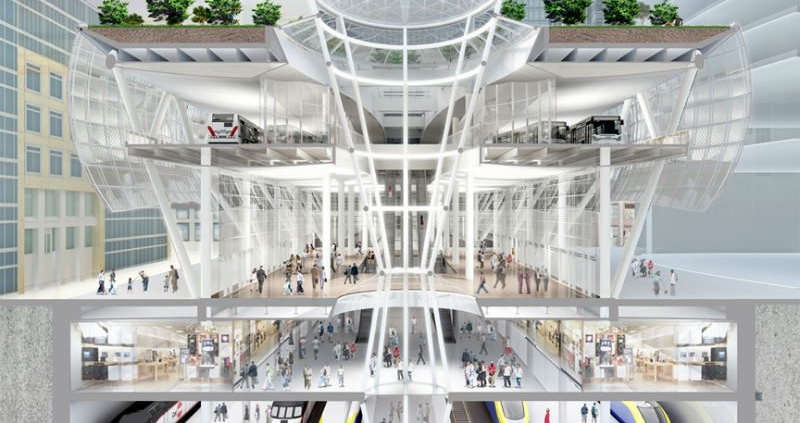A New Era In Transportation Investment
The image above is a rendering of the new San Francisco Salesforce Transbay Transit Center, construction was funded by Salesforce.com Inc (California High-Speed Rail Authority’s sustainability report)
There are few forces in the history of the United States that are as impactful as transportation. Even from the earliest days of the Republic, leading politicians such as Henry Clay and Daniel Webster promoted an “American System” of roads and canals to connect the country together, knowing that where transportation infrastructure went, wealth and economic opportunity would follow. The expansion of the country across the west and the consolidation of the frontier was symbolized by the harbinger of development, the steam train. At the turn of the century, new investment in railways created some of the largest fortunes of the Gilded Age and became a symbol of cutthroat capitalism and growth at any cost. After the Second World War, President Dwight Eisenhower championed his Interstate Investment Plan as an economic and military necessity, as only comprehensive highways that knit the country together could facilitate the movement of goods in times of peace or troops in times of war.
The country is in need of another great wave of transportation investment. The great migration of professionals back to American cities has put strain on both automotive and transit infrastructure. While few public services are delivered without issue, public transit appears to have become the problem child of every big city government. Hamstrung by aging systems and increasing demand, public transit systems must navigate labor politics and user satisfaction while upgrading their constantly-in use networks for the 21st century. Increased demand brings the potential for increased funds, but without large up front investments users may find alternatives. The difficulties in finding capital for these investments has led American cities to choose divergent tracks to meet their citizens transit needs. New York City has recently increased taxes on ride-sharing services like Uber and Lyft, with the goal of placing these newfound funds at the disposal of the city’s public transit system. The City of Denver, on the other hand, has partnered with Uber to help commuters plan their trips using a mix of the ride-sharing service and Denver Mass Transit. Beyond government bodies, individual commuters and advocacy groups have taken upon themselves to find areas of waste that could be cut, from identifying inefficient bus routes to promoting new fare pricing strategies.
Outside of cities, the way America moves goods and people across the country are more in question than any time in the last fifty years. Just as in the era of steam and rail, both public and private groups have stepped forward to invest. While many local and state have renewed their commitment to transportation infrastructure, private companies have also stepped up to make sure their employees and products make it from A to B. Ideally the common interest in reliable transportation options would bring these two parties together. Public-private partnerships, referred to in the industry as “P3s”, are one way in which the goals of public organizations and the resources of private groups can unite. This participation typically involves the private sector taking on additional project risks such as design, construction, finance or long term operations, areas where government bodies may feel out of their element. In return, private groups can incentivise project development in areas where they do business and sometimes can shape investment and planning to meet their needs. The Boston Landing MBTA Commuter Rail Station, a joint venture between MBTA and New Balance Athletics, is one such example of this. With a new headquarters campus situated in Allston-Brighton, New Balance was incentivized develop the area and increase employee access to public transit. In return for allowing the shoe giant to build a mixed use development in the neighborhood, MBTA and the City of Boston were able to open a new commuter rail station to the Brighton, Allston and Brookline communities. Still, public representatives and private companies will not always agree on where resources should be allocated, and the potential conflict between greater public good and firm profits is something both parties must continue to keep in mind.
Still, many of the great transportation projects of the 21st Century will need technical expertise and capital beyond that government can bring to to bear. California Governor Gavin Newsom recently announced his plans to “de-prioritize” a high speed rail line running from San Francisco to Los Angeles. Not four months earlier, Elon Musk announced the initial tests of his California hyperloop project, a high speed transit system that he claims could be built on existing infrastructure. If the government of California finds itself unwilling or unable to invest in transit infrastructure, perhaps Mr. Musk’s project can pave the way for private industry taking the lead in investing in America’s transportation future.




Leave a Reply
Want to join the discussion?Feel free to contribute!